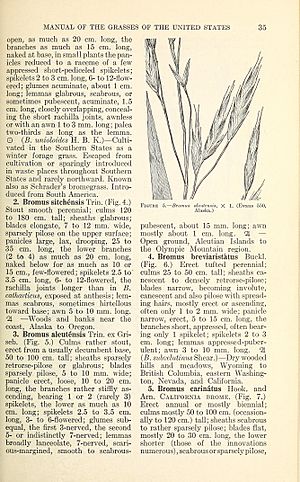Aleutian brome facts for kids
Quick facts for kids Aleutian brome |
|
|---|---|
| Scientific classification | |
| Genus: |
Bromus
|
| Species: |
aleutensis
|
The Aleutian brome (scientific name: Bromus aleutensis) is a type of grass that grows year after year. You can find it in North America. This grass has 56 chromosomes in its cells.
About Aleutian Brome
Scientists think that Aleutian brome might be a special version of another grass called Bromus sitchensis. It might have changed to grow and reproduce faster because of the cold weather in the Aleutian Islands.
Most Aleutian brome plants can fertilize themselves. This means they don't need pollen from another plant. But some plants have longer anthers, which are parts that hold pollen. Anthers about 4.2 mm (0.17 in) long suggest these plants might sometimes share pollen with others.
What Does It Look Like?
Aleutian brome is a perennial grass, meaning it lives for more than two years. It often grows in loose clumps. Its stems, called culms, lie down at the base before growing upright. They can be 40–130 cm (16–51 in) tall and 3–7 mm (0.12–0.28 in) thick.
The leaf sheaths, which wrap around the stem, have thick hairs and lines. Small ear-like parts called auricles are rarely seen. The ligules, a small flap at the base of the leaf blade, are smooth and 3.5–5 mm (0.14–0.20 in) long.
The leaf blades themselves are somewhat hairy. They can be 13–35 cm (5.1–13.8 in) long and 6–15 mm (0.24–0.59 in) wide. The flowers grow in an open, branching cluster called a panicle, which can be 10–28 cm (3.9–11.0 in) long.
Flower Details
The lower branches of the flower cluster are about 10 cm (3.9 in) long. Each point on the stem has one or two branches. These branches have two to three small flower clusters, called spikelets, on their outer half.
The spikelets are shaped like an oval or a spearhead. They are 25–40 mm (0.98–1.57 in) long and have three to six tiny flowers inside. The protective leaves, called glumes, can be smooth or hairy. The lower glumes are 9–13 mm (0.35–0.51 in) long, and the upper ones are 10–15 mm (0.39–0.59 in) long.
The lemmas, which are part of each tiny flower, are 12–17 mm (0.47–0.67 in) long. They are flattened on the sides and softly hairy. They have nine to eleven veins, which are easy to see near the tip. The awns, which are bristle-like parts, are 5–10 mm (0.20–0.39 in) long. The anthers, which hold pollen, are 2.2–4.2 mm (0.087–0.165 in) long.
Where It Grows
You can find Aleutian brome growing in sand, gravel, and disturbed soil. It is common along the Pacific coast. It grows especially from the Aleutian Islands (which is why it's called "Aleutian") all the way to western Washington. It has also been found further east, near lake shores or roadsides in Canada and Idaho.
Plant Health
Like other plants, Aleutian brome can get sick. It can be infected by two types of fungi: Fusarium nivale and Hendersonia culmicola.


